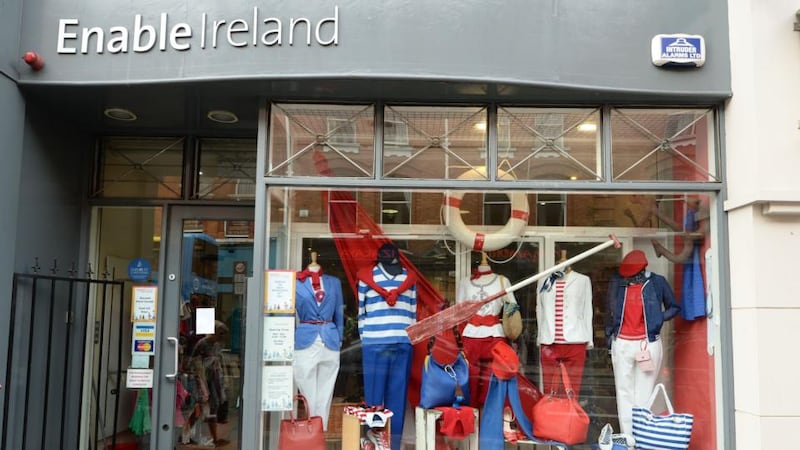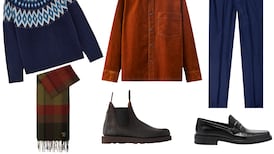If eyes are the windows to the soul, then shop windows are the soul of what’s on offer inside. A good shop window will make you stop and look; a great window will make you go inside. But how do you dress a window when the shop’s stock changes daily and you never know exactly what it’s going to be selling next?
Anne Marie Keeley has worked for the Enable Ireland chain of charity shops for 25 years. For the past 18 years, she has dressed the windows of several of the 21 shops the charity has around the country. The shop on Dublin’s South Great George’s Street is its best-known due to its location, and it is part of a cluster of many other charity shops that run all the way along Camden Street into Rathmines.
The day I meet Keeley, she is at the Finglas branch, dressing its two windows. In addition to being able to build a window display back to front, she also has to be as agile as a gymnast, because the space is so tight to work in.

“We were the first of the charity shops to dress our windows,” she says. “I ran this shop here 25 years ago, and I’d stay at night every fortnight or so to do the window. The locals used to call us Little Arnotts. Having a good window definitely makes a difference. People can see the potential in things they can get for a great price.”
Particular challenge
The biggest challenge of styling windows for a charity shop is that Keeley never knows what’s going to be there. Like many such shops, Enable Ireland is entirely dependent on donations for its stock. So how she tends to work is, when she sees a key, interesting item in a shop, she will ask the staff to keep it so she can build a window around it next time. Currently in the store room at Finglas is a real His Master’s Voice gramophone, in working order, which will be the star of her next window there.
Sometimes, Keeley does themed windows, which have included Wimbledon, nautical themes, picnics, Hollywood, DIY, spring and gardening. Today, there isn’t a specific theme; she has gone for a fresh summery look, with pinks and greens, featuring a fair bit of bric-a-brac.
In fact, the best-selling items are bric-a-brac, and not clothes, as you might expect. (Women’s clothes are the second best-seller.) “Men love bric a brac. Women get rid of it, and men buy it,” she says, arranging a plate of porcelain thimbles and four Chinese dolls.
The staff have kept aside a few items of clothing for her, including a lovely draped silk sage-green dress, which a customer eyes longingly on the mannequin. But pretty much everything else for the windows is picked up on the hoof in the shop. I watch as Keeley does a quick trawl, picking out various bags, shoes, scarves and items of jewellery to colour-coordinate with the clothes. A woman arrives to drop off some bags, one of which contains boxes of shoes. They don’t even make it into the store room, before Keeley has swooped and taken an unworn pair of sandals for her window. She never had any formal training, but it’s clear she has a natural flair for the job, which she loves.
Various props
Keeley travels around to the different charity shops in a little van, which is permanently full of various props. At the moment it’s stuffed with props for the window she’s doing the next day in Navan, which will feature American designer menswear. There are picnic baskets and trunks, some of which she has been using for years. They too are all donated items, except these are not for sale, as they are so useful for display. (While I am in the Finglas shop a customer gets very upset when she realises the basket full of skeins of wool that she wants to buy for her “very hairy cat” is not for sale.)
“Sometimes our windows look so good that people who come in forget we’re a charity shop. They’ll say things like, ‘Have you this dress in a size 14?’ I don’t know if it’s a good thing or a bad thing,” Keeley says as she hangs up pink lanterns.
Manager Anne Hunt tells me a story of one woman who definitely knew the Finglas shop was a charity shop. “She came in about six years ago, with a four-year-old boy who was holding a pirate ship. She told him to put it up on the counter, and I could see he didn’t want to.”
The mother told Hunt that the pirate ship was her son’s favourite toy, and because he had been naughty, he now had to give it away to charity. Horrified, Hunt told the boy he didn’t have to part with it, but the mother put it up on the counter and the two of them walked out.
The story has a gothic ending. The next day, a woman came in and bought the ship. She told Hunt her brother was dying of cancer and he wanted his ashes scattered at sea. “She said she was going to put his urn on the pirate ship and send it out to sea.”
So if there is somebody reading this who had to part with his pirate ship as a child, you should know that it went to a good cause. As Keeley says, “In a charity shop, you never know what’s going to come in the door next.”
- Enable Ireland and all other charity shops rely on donations to stock their shops. Remember them when you are clearing out











